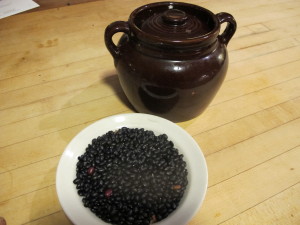Eating My Own Veggies
A dozen years ago I decided to become rich and famous by writing a bestselling book. I would travel the country, talking to farmers – some conventional, some organic, some using that “new” technology of the time, GMO agriculture. I thought my book would explain what eaters wanted to know about how their food was produced. It would outsell Fast Food Nation.
I outfitted my aging van with a bed, a fridge and a small battery-operated fan for those days when the temperatures exceeded 100 degrees (the van had no AC). I drove across the country, talking to farmers along the way. I had made arrangements to work on a 300 acre organic farm in Idaho for a few weeks, working alongside the Peruvian laborers. Unfortunately, I never found a publisher for the idea, so I never wrote the book. But I learned a lot about commercial agriculture.
In Idaho, I remember bouncing along on the back of a 4-wheeler to see a conventional potato farmer’s fields. He stopped and added 4 ounces of fungicide into an irrigation pivot that served 30 acres of potatoes. What would happen if one of his laborers, many of whom do not read English, had added a quart of fungicide instead of 4 ounces? And why, I wondered, did the farmer have a garden where his wife grew veggies for their use, including potatoes? That reinforced my conviction that I want to eat organic food, preferably food I grow myself.
This past summer I had access to a large field that been tended organically for years, but allowed to go fallow. I grew potatoes, tomatoes, squashes of all sorts, corn, beans and more. I called it my farmette.
In the past I had only grown beans for fresh eating or for freezing. But with plenty of space, I also grew beans for drying despite the fact that dry beans are not expensive – at least not the conventional ones. Still, I thought, wouldn’t it be nice to make baked beans or chili just using my own dry beans?
Dry beans are a lot of work – beyond just planting, weeding and protecting from the deer (who love them). The bean pods must get totally dry either in the field or in the barn or house. In good weather, letting them dry on the vine is best. Then they must be threshed or hulled. That means getting every last seed out of the shells, which can be tedious. And it is hard to get all the bits of the outer hulls separated from the beans. Winnowing outdoors on a windy day is the easiest way to do so. Fortunately my partner, Cindy, finds getting dry beans ready for winter use to be a nice contemplative task.
Invited to a solstice potluck, I decided to make a pot of baked beans just using my own ingredients – or as close to it as possible. The beans were a big success, so I’m sharing the recipe with you. And, obviously, you can buy the beans or anything else you lack from your own garden.
½ lb. bacon, chopped (optional)
2 cups dry black beans, soaked overnight in plenty of water
3-4 cups chopped tomatoes – frozen whole, or from a can
2 large onions, chopped medium to fine.
2 cloves, minced
2 cups dried pears or other dried fruit (apricots work well, too, but use less)
1 to 2 cups dried cherry tomatoes
3-4 ounces tomato paste
1 teaspoon dry mustard
1 tablespoon Herbes de Provence (or rosemary and thyme)
Dried hot pepper to taste – ½ teaspoon of chipotle is a good start. Jalapenos or Espellette are good, too.
½ cup maple syrup or more, to taste
Salt and pepper to taste
Water as needed.
I began by rinsing the beans that had soaked overnight, and cooking them for an hour with plenty of water. They soak up considerable water.
In a heavy enameled pot I fried the bacon, then drained most of the fat. I used a local thick-cut smoked bacon, Garfield’s, from Meriden, NH – just down the road from me. Then I added the onions, and cooked at low heat until translucent. If making vegetarian beans, use olive oil to sauté the onions.
To the onions and bacon I added the beans and immediately covered with water. I added the chopped tomatoes that I had frozen whole last summer, the tomato paste, the maple syrup, spices and garlic, and continued cooking at low heat. The beans should be covered with liquid at all times.
Dried pears or other fruit add a nice sweetness to the beans, but you can add more maple syrup instead. I chopped my pears into small pieces, and added them with the dried cherry tomatoes to the pot.
I cooked the beans on the stove top for an hour, tasting often to see if I needed more hot peppers, other spices or maple syrup. Then I transferred everything into a ceramic bean pot and put it in the oven, covered, for another 2 to 3 hours at 300 degrees. Watch out for juices bubbling over – I always keep a cookie sheet under the pot. Add water if the beans get too dry.
For me, at least, eating something wonderful created from my own veggies and fruits is a real treat. I know that it has no toxic chemicals and that the ingredients have been grown with love. So start planning your vegetable garden now – the days are already getting longer.
Henry is the author of 5 books. His website is www.Gardening-guy.com.



